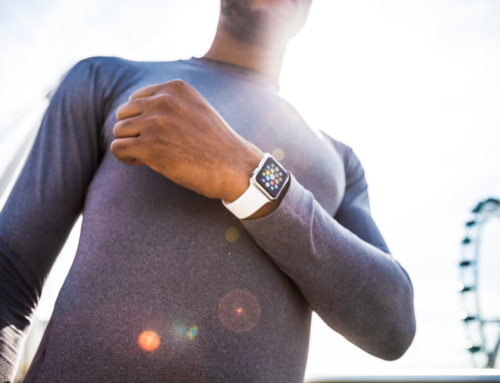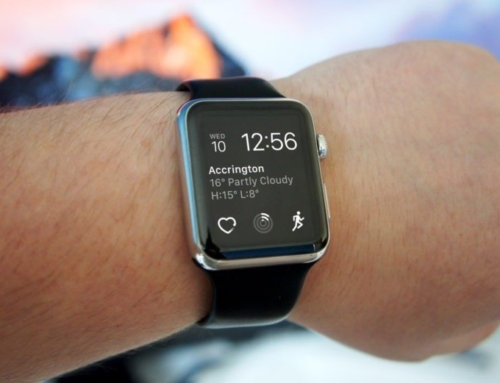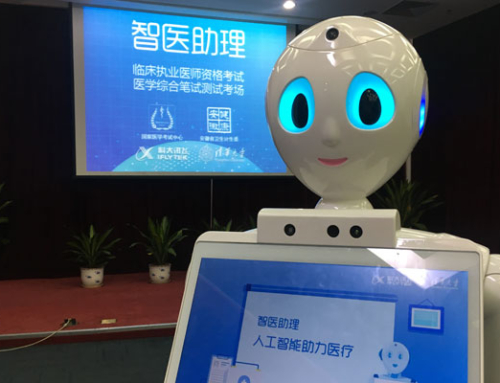By Glenn Fox, PhD, Shaun Garland, PhD, Andrew Keibel, MD & Leslie A. Saxon, MD | Sep 14, 2017
Wearable technology can benefit health only if it leads to enduring behavior change. There are more than 1,000 commercially available wearable devices that can be paired to a software application (app) to measure and improve health behavior, and one in five Americans has purchased one. Despite their ubiquity, there has been little systematic measurement and understanding of how people use and stop using them. The research that does exist, emerging mostly from market research white papers, tells a story of rapid abandonment. Most users report increased physical activity after purchasing a sensor, but the longer they own it, the less they use it: nearly one third of all users cease tracking activity six months after purchase.
In order to derive sustained health benefits from activity sensors, it is important to understand why users often abandon their devices. Qualitative analyses of the reasons include forgetting to wear the device, discomfort during exercise, lack of aesthetic appeal, and loss of interest. In some cases, users report they have met their fitness goals and no longer rely on the device. Previous studies of device usage by small numbers of patients provide evidence that leveraging peer support to encourage activity and other healthful habits achieves more favorable health outcomes than self-motivation.
To the best of our knowledge, no studies have prospectively investigated how targeting specific personality traits or using motivational tactics, besides peer support, can influence continued use of wearable activity sensors and apps. These factors are known to have an impact on consumer behavior and engagement with other health products. For example, one study showed that providing elderly subjects with “altruistic” incentives that benefit another person resulted in increased engagement with repetitive exercises aimed at enhancing cognition.
At the USC Center for Body Computing, we created the Virtual Care Clinic, a 24/7 model of digital health care that occurs outside of the walls of a brick-and-mortar health care facility. Creating this model of carerequires a deep understanding of how to motivate users to actively engage in their health care over time. The clinic partnered with VSP Global®, one of the largest insurers of vision care in the world, to assess how individual differences in personality and social behavior predict use of an activity-tracking hardware and software platform in a large and diverse insured employee population.
VSP Global’s innovation lab, The Shop, created a hardware and software platform (Level™) for the study. An activity sensor was embedded in the arm of specially designed prescription glasses that paired to a mobile app.

Click To Enlarge.
The study was novel in that it did not require participants to use an additional wearable item, but instead put to use an object they already needed to wear daily for vision acuity, obviating some of the usage barriers — such as inconvenience and discomfort — reported in other studies.

Click To Enlarge.
We tested several hypotheses:
- Identifiable personality traits can predict user engagement.
- The use of motivational prompts and social networks enhance engagement and thus daily activity levels.
- Easy-to-use hardware and software and positive user interface/user experience (UI/UX) is critical to sustaining engagement over time.
The Study
A total of 284 University of Southern California employees, who were 18 or older and VSP beneficiaries, enrolled in the study, which ran for 15 weeks in 2016. All participants wore prescription eyeglasses daily and had smartphones. They completed a baseline questionnaire to assess commonly measured personality traits. We measured the “Big-Five”dimensions of personality (openness, conscientiousness, extraversion, agreeableness and neuroticism), as well as inclination to feel gratitude,positive and negative affect, and satisfaction with life. Participants received an eye exam to update their prescription prior to receiving the study glasses. The USC Center for Body Computing hosted a one-day launch event for participants to fit their eyewear and receive a hardware and software tutorial.
The sensor in the glasses captured users’ daily activities (steps, distance, calories, active time) and transmitted the data via Bluetooth to their smartphones. When participants met their daily step goals 50 times, a donation of a free eye exam and prescription glasses was made to an underserved group of the subject’s choosing, such as low-income children, the elderly, veterans, or individuals affected by homelessness through VSP Global’s Eyes of Hope® charitable giving program.
The app also connected study participants with each other through a social network that enabled them to “friend,” view, comment on, and “like” each other’s activities. Additionally, prompts were sent within the app to encourage users to complete their daily step goal. The prompts were either altruistic (“You’re x steps away from your goal. Keep going to give someone the gift of sight”), or self-focused (“You’re x steps away from your goal. Keep going for a healthier you”).
After completion of the study, participants filled out surveys assessing their opinions of the platform, how they used the platform, frequency of participation in the app’s social network, and the degree to which charitable giving and social interaction in the app played a role in motivating their physical activity.
Results
From the initial 284, nine participants never used the platform, leaving 275 who completed the study enrollment and used the app. Of those 275, 221 participants (80%) used the platform for the duration of the study. Subjects were 61% female and 37% Caucasian, with 44% between ages 18 and 39, 48% between 40 and 59, and 7% between 60 and 79. The mean body mass index (BMI) was 28.
Participants recorded daily mean step totals of 1,956 (standard deviation = 2,021; range = 50-11,478). Mean daily steps declined over the course of the study, peaking at day 11 and at their lowest on day 107. Weekly activity levels were highest on Tuesday, and declined throughout the week to their lowest levels on Sunday.

Click To Enlarge.
Demographics, Personality Measures, and Activity
Baseline characteristics that predicted higher activity levels were older age and greater life satisfaction. In post-study personality measurements, higher mean physical activity was predicted by greater motivation for charitable giving and social relationships to reach fitness goals.
Social Network, Prompts, and Activity
Motivational prompts and the number of friends, likes, and comments from the app’s social network were strong and independent predictors of higher activity levels.
People who received prompts were more active than those who did not, and prompts that motivated self-improvement were equally as effective as those that encouraged altruistic behavior.
Hardware and Activity
Subjects felt that having the activity tracker embedded in their prescriptive eyewear, versus in a separate wearable, was the most valuable aspect of the platform. Additionally, a positive perception of frame comfort, fashion, and ease of sensor charging also positively associated with activity.
Software and Activity
Activity was significantly correlated with participant perception that the app was efficient, attractive, and novel.
The most commonly reported technical problem with the app was intermittent difficulty syncing with the sensor, which was reported by 62% of subjects.
Discussion
The activity tracking and use abandonment rates over the course of the study are consistent with existing data on user engagement with body worn sensors designed to track only activity (unlike the study sensors that were embedded in prescriptive eyewear). This suggests that even though many subjects felt that having the sensor embedded in well-designed prescription frames was one of the most attractive features of the platform, that benefit was not enough to overcome other limitations, such as the app sometimes not syncing with the sensor. This is disappointing, as our population, with an average BMI of 28, was overweight and at risk of developing health issues like diabetes and hypertension and could have benefited from continued use.
The most important personality and subjective measure for predicting mean daily steps was satisfaction with life. This relationship is consistent with other reports that have shown that individuals demonstrating higher levels of emotional stability, extraversion, openness, agreeableness, and conscientiousness are more likely to exercise regularly. A novel feature of our study was its attempt to use altruistic and self-focused (“intrinsic”) motivations — as opposed to tangible (“extrinsic”) rewards, such as a gift, to encourage activity. Although both types of intrinsic motivation cues were equally effective, we believe that our findings complement previous reports that those with optimal exercise habits are intrinsically motivated to do so (i.e., exercising for self-improvement). Based on these studies, the specific extrinsic and intrinsic factors for motivating daily activity should be at the forefront of wearable technology design, with an emphasis on leveraging intrinsic benefits.
This investigation did not demonstrate a measurable improvement on previous reports of user drop-off. Participants reported frustration with the app’s syncing and function, and we think this may have contributed to the drop-off in use. Notwithstanding this frustration, participants reported strong satisfaction with having the sensor embedded in their glasses and the overall design of the platform. We believe this positive response underscores the value of measuring and motivating activity while using devices embedded in everyday items such as prescriptive and non-prescriptive eyewear.
We expect that our findings will lead to improvements to the software, hardware, and motivational strategies used by wearables and thus stronger user engagement over time. We also intend for this study to influence future device design by unpacking why usage may or may not decline, in terms of personality traits and dispositions, as well as which key product features, such as the ability to socialize with others or to fulfill charitable inclinations, are important for engaging users in healthful behaviors.
We aim to publish more detailed reports of this dataset, and to continue working with patients, health care providers, insurers, and designers to better understand how to build wearables that will positively impact health. The purchase of a wearable sensor reflects a desire to improve health. It is the responsibility of medical professionals, designers, and researchers to create a user experience around the hardware and software components of the sensor that is compelling enough to help people realize these goals.
Acknowledgements from the authors: We would like to thank our colleagues from the USC Center for Body Computing, Mona Sobhani, PhD (Research Lead) and Julie Berkley and Benjamin D. Nguyen (Project Coordinators). We would also like to express our gratitude to our partners at VSP Global for their work and vision: Jay Sales (Co-Director, The Shop at VSP Global), Leslie Muller (Co-Director, The Shop at VSP Global), and Christine Folck (Program Manager, The Shop at VSP Global), as well as our partners at the USC Roski Eye Institute, including Gloria Chiu, OD, FAAO, FSLS (Assistant Professor, Clinical Ophthalmology).










